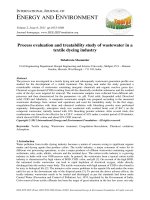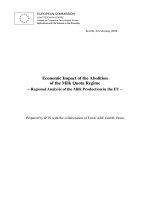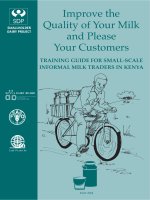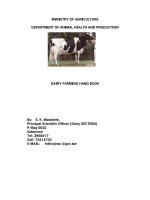Sensory evaluation and production cost of almond milk shake
Bạn đang xem bản rút gọn của tài liệu. Xem và tải ngay bản đầy đủ của tài liệu tại đây (213.47 KB, 6 trang )
Int.J.Curr.Microbiol.App.Sci (2019) 8(1): 2077-2082
International Journal of Current Microbiology and Applied Sciences
ISSN: 2319-7706 Volume 8 Number 01 (2019)
Journal homepage:
Original Research Article
/>
Sensory Evaluation and Production Cost of Almond Milk Shake
D.D. Kuchekar, S.G. Narwade and S.V. Gaikwad*
Department of Animal Husbandry & Dairy Science, Vasantrao Naik Marathwada Krishi
Vidyapeeth, Parbhani, 431 402 (M.S.), India
*Corresponding author
ABSTRACT
Keywords
Almond, Buffalo
milk, Sugar,
Chemical
composition, Cost
of product
Article Info
Accepted:
15 December 2018
Available Online:
10 January 2019
Milk shake is a frozen dairy product, prepared from milk and ice cream mixing into mixer
to make it pourable and generate foam in it. It can be made more nutritious and health
protector with addition of almond (Prunus dulcis) due to its rich mineral contents, zero
cholesterol level, and health invigorating antioxidant, anti-cancerous and antibacterial
properties against harmful pathogens. There has been no scientific study on milk shake
blended with almond (Prunus dulcis) particularly from buffalo milk, which is more
nutritious, and rank higher with respect to sensory appeal over cow milk. Milk shake was
prepared from different proportions of milk shake from buffalo milk blended with crushed
almond viz. 5%, 10% and 15%. Comparison between the treatment samples revealed that
milk shake with 5 % almond had significantly (P<0.05) higher in Colour and appearance
(8.33%), Flavour (8.52%) and Body and Texture (8.49%) than the other two levels (5%
and 10% almond). The overall acceptability score (8.44) was the highest in the sample
with 5% almond. The production cost of milk shake with 5% almond (Rs.99.5) was lower
than the other two samples. The study tends to conclude that milk shake prepared from
buffalo milk with a blend of 5% almond was more consumer-friendly than buffalo milk
shake (control) due to its better sensory appeal and high nutritive value and was more costeffective than the other two variants.
Introduction
Milk shake is a western dairy product
obtained by freezing a mix very similar to soft
serve ice cream mix and speedy mixing the
frozen product in a mixer to make it pourable
and generate foam in it. The milk shake that
are commonly sold in the India subcontinent
consist of sweetened cold milk added with
colouring and flavouring agents without
freezing but vigorously shake. The most
commonly used flavour blends are of rose,
coffee and chocolate. Milk shake is sold by
fruit juice centres in many parts of our
country during the whole years. It is liked
most by consumer as it is palatable and
nutritional (Kadav, 2001).
Today’s consumers are increasingly seeking
functional foods for their health and well
being as means of intervention in disease
prevention. Due to the today’s upward
consumer awareness and interest to follow
healthy nutrition and dietary strategy in
2077
Int.J.Curr.Microbiol.App.Sci (2019) 8(1): 2077-2082
achieving health benefits from food beyond
their basic nutrition the market for value
added foods has expanded manifolds. In the
food processing industry the dairy sector has
depicted value addition (35%) whereas in the
case of total agriculture it is only 2 per cent.
Almonds are one of the most nutritious of all
nuts. Almonds are rich in vit. E (tocopherol)
flavonoids and other antioxidants and it help
in lowering the bad cholesterol. Almond is
very low in carbohydrate so it is perfect for
low carbohydrate diets. It can help in burning
fat because it is low in calories. Almonds are
rich source of some essential minerals such as
magnesium and calcium. Almond contains
copper in organic form @ 15 mg per 100 gm,
almonds are therefore useful food for
consumer. Sweet almond oil is one of the
most popular oil used in aromatherapy.
Regular consumption of almond all helps to
reduce cholesterol, nourishment of brain and
enhances intellectuality. It has been seem to
be beneficial in combating life style decrease
such as cardiovascular disease. Almond helps
in fighting diabetics and heart disease.
Several types of milk shake are sold in the
market i.e. mango milk shake, sapota milk
shake, fig milk shake, banana milk shake,
almond milk shake, custard apple milk shake
and the method of manufacture of milk shake
vary from region to region. The base for all
this type of milk shake is however milk and
cane sugar in different proportion and other
specific ingredient are incorporated to cater.
The special taste, the milk shake shows wide
variation in method of manufacture. No
attempts have so for been made to formulate
quality standard for this product. The paucity
of adequate published information of almond
milk shake, is the main constraint in
determining the legal standard therefore it is
an immediate need for standardizing suitable
methodology for preparation almond milk
shake so that the chemical quality of almond
milk shake could become uniform.
Materials and Methods
The whole, fresh, clean buffalo milk was
obtained from buffalo unit maintained at
Department of Animal Husbandry and Dairy
Science, College of Agriculture, Vasantrao
Naik Marathwada Krishi Vidyapeeth,
Parbhani. Milk was standardized to 6 per cent
of fat and 9 per cent SNF by Pearson’s
formula. Almond, Sugar and other ingredients
were obtained from the local market of
Parbhani. Different equipments viz., Karahi,
Khunti, stainless steel trays, mixer grinder, etc
were available in the department. Analytical
reagent grade chemicals were used for the
chemical analysis.
Treatment details
T0 =
Market almond milk shake (Control)
T1 =
5 parts crushed almond + 95 parts
buffalo milk (w/w)
T2 =
10 parts crushed almond + 90 parts
buffalo milk (w/w)
T3 =
15 parts crushed almond + 85 parts
buffalo milk (w/w)
Preparation of almond milk shake
Almond milk shake was prepared by following
the procedure as per Sharma and Gupta
(1978) with slight modification. The
measured quantity of fresh buffalo milk was
filtered through muslin cloth. The buffalo
milk was standardized to 6 per cent fat and 9
per cent SNF. Milk was kept in karahi for
heating and sugar was added @ 10. The
crushed Almonds were added @ 5, 10 and 15
parts as per level of treatment. It was mixed
well, kept in deep freezer and blended in
mixer and almond milk shake was ready to
serve.
2078
Int.J.Curr.Microbiol.App.Sci (2019) 8(1): 2077-2082
Flow diagram of preparation of almond
milk shake
Receiving of buffalo milk
The cost towards fuel and other items was
considered under miscellaneous charges.
Statistical analysis
o
Preheating of milk (35-40 C)
The data were subjected to statistical analysis
by using Completely Randomized Design as
described by Panse and Sukhatme (1967).
Filtration
Standardization (Fat – 6%, SNF-9%)
Results and Discussion
Heating of milk (71oC for 30 min.)
The values for proximate composition,
sensory evaluation and production cost
parameter are presented in Table 1 and 2.
Addition of sugar @ 10 per cent
Addition of crushed almond (As per treatments)
Ageing of mix at 6-10oC for 2-3 hrs.
Sensory evaluation of almond milk shake
Deep Freezing the mix (-2 to -60C)
The almond milk shake prepared from
different blends of crushed almonds and
buffalo milk was subjected to sensory
evaluation and scores recorded for different
parameter.
Addition of flavour (cardamom @ 1%)
Blending mix in mixture (for 1-2 min.)
Milk shake
Sensory evaluation
Colour and appearance
The sensory characteristics, viz., colour and
appearance, flavour, body and texture and
overall acceptability were evaluated by a
panel of five assessors using “9-point
Hedonic scale” developed by Quarter Master,
Food and Container Institute, USA (Gupta,
1976). The scores ranged between 1 and 9,
depending upon the liking. The descriptors
were, extremely liked (9), liked very much
(8), liked moderately (7), liked slightly (6),
neither liked nor disliked (5), disliked slightly
(4), disliked moderately (3), disliked very
much (2) and extremely disliked (1). The
scores were pooled and mean score for overall
acceptability was worked out (Fig. 1).
The mean colour and appearance score for
different treatment of almond milk shake
ranged from 7.95 to 7.97. The treatment T1
(8.33) was found to be significantly superior
over the rest of the treatments. It was
observed that increased level of almond in
almond milk shake also increased the score of
colour and appearance slightly. The results
obtained for colour and appearance were
comparable with those of Pakalwad et al.,
(2010) observed that the colour and
appearance score for different treatment of
papaya milk shake ranged from 8.07 to 8.33.
Mule et al., (2014) stated that the score of
appearance for fig milk shake ranged between
8.06 and 8.38.
Cost of production
Flavour
The ingredients required for preparation of
almond milk shake was calculated on the
basis of prevailing market price and cost per
liter of almond milk shake was worked out.
It was observed from Table 1 that, the mean
score for flavour of almond milk shake for
treatments T0, T1, T2 and T3 was 8.03, 8.52,
2079
Int.J.Curr.Microbiol.App.Sci (2019) 8(1): 2077-2082
8.47 and 8.22, respectively. The treatment T1
was significantly superior over T0 and T3
treatments. However, the flavour score of
treatments T2 was at par with treatment T1. It
was observed from above findings that 95 per
cent buffalo milk blended with 5 per cent
almond gave rich flavour to milk shake. The
results obtained in this study are in close
agreement with those of Pakalwad et al.,
(2010) observed that the mean score flavour
of papaya milk shake ranged from 8.15 to
8.52. Mule et al., (2014) reported that the
mean score of flavour for fig milk shake in
between 8.04 to 8.29.
Table.1 Sensory parameter of almond milk shake
Parameter
Control
5% almond
10% almond
15% almond
S.E.
CD at 5%
Colour & Appearance
7.95
8.33
8.24
7.97
0.024
0.075
Flavour
8.03
8.52
8.47
8.22
0.054
0.016
Body & Texture
8.22
8.49
8.36
8.18
0.12
0.37
Overall acceptability
8.06
8.44
8.35
8.12
0.10
0.30
Table.2 Production cost of almond milk shake for 1Kg
Sr.
No
Components
Unit Cost
(Rs.)
5% Almond
10% Almond
15% Almond
Qty.
(g)
Amt.
(Rs.)
Qty.
(g)
Amt.
(Rs.)
Qty.
(g)
Amt.
(Rs.)
40/ litre
950
38.00
900
36.00
850
34.00
1
Buffalo milk
2
Sugar
25/ kg
100
2.5
100
2.5
100
2.5
3
Almond
900/ kg
50
45
100
90
150
135
4
Cardamom
2000/kg
1
2
1
2
1
2.00
5
Labour
1.5/h
1
1.5
1
1.5
1
1.5
6
Electricity
0.50
--
0.50
--
0.50
--
0.50
7
Fuel
5.00
--
5.00
--
5.00
--
5.00
8
Miscellaneous
5.00
--
5.00
--
5.00
--
5.00
--
--
99.5
--
142.5
--
185.5
Total
2080
Int.J.Curr.Microbiol.App.Sci (2019) 8(1): 2077-2082
Fig.1 Effect of different levels of crushed almond on overall acceptability score of almond milk
shake
Body and texture
The mean score for the body and texture
attributes of almod milk shake it was in the
range of 8.22 to 8.18. The score recorded
seems to be highest for T1 (8.49) and lowest
8.18 as (T3). The treatment T1 (8.49) was
significantly superior over rest of the
treatments. The body and texture score for
treatment T1 and T2 were at par with each
other. The addition of almond in the blend,
improve the body and texture of the milk
shake. The results obtained are in agreement
with those of Kashid (2005) prepared almond
milk shake from cow milk blended with
safflower milk and reported the body and
texture score for almond milk shake varied
from 7.41 to 8.21. Mule et al., (2014)
observed that the score of texture for fig milk
shake ranged between 8.16 and 8.29.
Overall acceptability
The mean score for treatment T0, T1, T2 and
T3 were 8.06, 8.44, 8.35 and 8.12
respectively. The treatment T3 (8.12) having
least overall acceptability score. The
treatment T1 (8.44) was most acceptable by
the judges. So that, 5 per cent level of almond
was most acceptable but the other treatment
combinations are also acceptable but in
descending value. The mean score of overall
acceptability showed decreasing trend, i.e.
with increase in level of almond, there was a
decrease in the acceptability of the finished
product. The results recorded in this study in
comparable with the results obtained by
Pakalwad et al., (2010) observed that the
overall acceptability score for different
treatment of papaya milk shake ranged from
8.03 to 8.56. Mule et al., (2014) stated that
the mean score of fig milk shake for overall
acceptability ranged between 8.11 and 8.30.
Production cost
It was observed from Table 2, the cost of the
production of almond milk shake per kg for
treatment T0, T1, T2 and T3 was Rs.54.5, 99.5,
142.5 and 185.5, respectively. The almond
milk shake prepared from buffalo milk and
almond (95 per cent buffalo milk and 5 per
cent almond) T1 was most accepted to the
judges. It was costlier than normal (control)
milk shake. The treatment T1 was economical
than rest of the treatments. Treatment T1
2081
Int.J.Curr.Microbiol.App.Sci (2019) 8(1): 2077-2082
scored the highest score by the panel of
judges and rated between like very much to
like extremely. The results obtained in this
study are in agreement with those of Mule
(2014) who prepared fig milk shake and
reported production cost of finished product
ranged as Rs. 73.50 to 90.00/lit.
In conclusion, the almond milk shake is very
refreshing, high in nutritive value and was
prized for its medicinal properties. Almond
milk shake product would be more palatable
and nutritive. All the levels of crushed
almond in milk shake i.e. 5, 10 and 15 per
cents were acceptable but the optimum level
of almond could be incorporated in the blend
up to 5 per cent was most acceptable and cost
efficient. The higher proportion crushed
almond utilized in the blend scored towards
lower side by panel of judges.
References
Gupta, S.K. 1976. Sensory evaluation in food
industry. Indian Dairyman, 28(7): 293295.
Kadav, V.B. 2001. Preparation of fruit
flavoured milk shake. M.Sc. Thesis
submitted to Dr. B.S.K.K.V., Dapoli,
Ratnagiri, M.S. (India).
Kashid, U.B. 2005. Preparation of golden
milk shake from cow milk blended with
safflower milk. M.Sc. (Agri.) Thesis,
MKV, Parbhani (India).
Mule, P.R., Barbind, R.P., Korake, R.L. and
Gavit,
D.P.
2014.
Proximate
composition, sensory evaluation and
production cost of fig milk shake
prepared from buffalo milk. Animal
Science Reporter, 8(2): 43-47.
Pakalwad, S.T., Awaz, H.B., Pawar, S.L. and
Paul, S.P. 2010. Preparation and
sensory evaluation of papaya milk
shake. Veterinary world, 3(4): 185-187.
Panse, V.G. and Sukhatme, P.V. 1967.
Statistical Methods for Agricultural
Workers. 2nd Edn., ICAR, New Delhi.
Sharma, A.K. and Gupta, S.K. 1978.
Manufacture of milk shake. Indian
Dairyman, 30(8):585.
How to cite this article:
Kuchekar, D.D., S.G. Narwade and Gaikwad, S.V. 2019. Sensory Evaluation and Production
Cost of Almond Milk Shake. Int.J.Curr.Microbiol.App.Sci. 8(01): 2077-2082.
doi: />
2082









